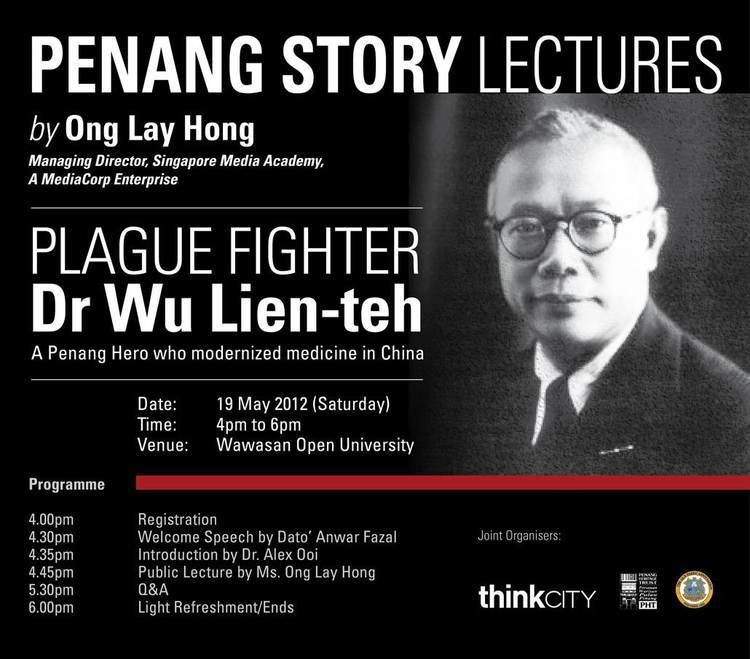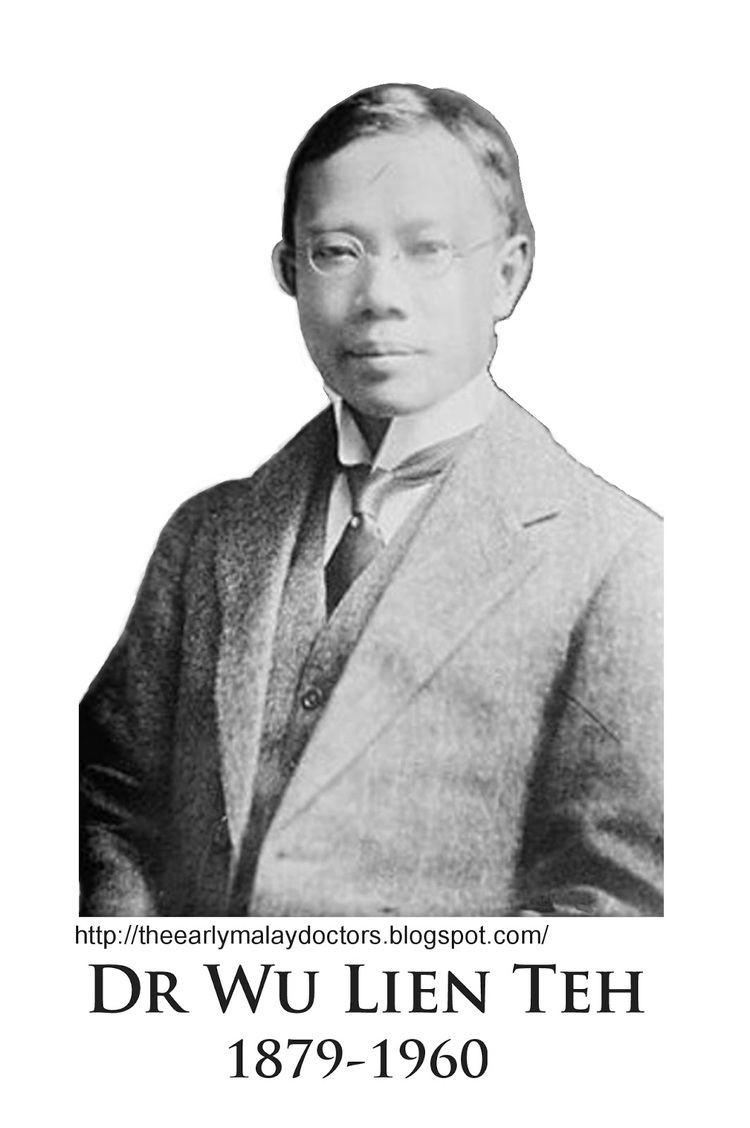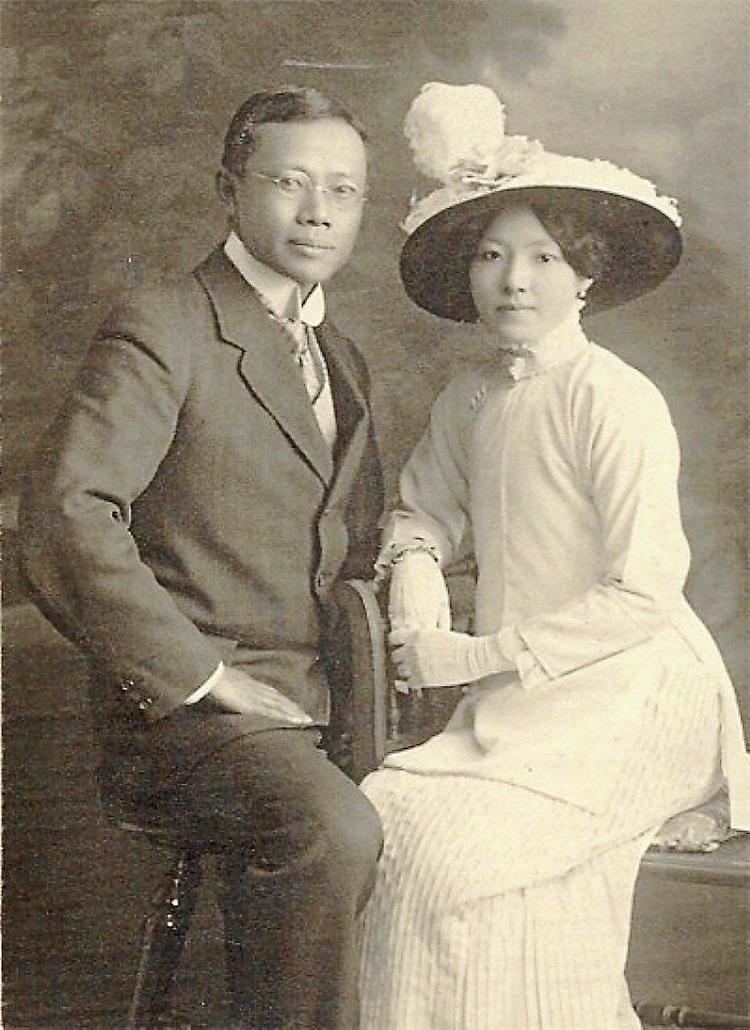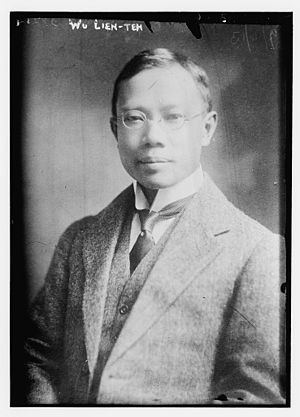Name Wu Lien-teh Role Doctor | ||
 | ||
Books History of Chinese Medicine: Being a Chronicle of Medical Happenings in China from Ancient Times to the Present Period | ||
the plague fighter dr wu lien teh
Dr. Wu Lien-teh (Chinese: 伍連德; pinyin: Wu Liándé; 1879 – 21 January 1960), also known as Goh Lean Tuck and Ng Leen Tuck in Minnan and Cantonese transliteration respectively, was a Malayan-born Chinese doctor and the first medical student of Chinese descent to study at University of Cambridge. He was also the first Malayan nominated for the Nobel Prize in Medicine in 1935.
Contents

Dr. Wu Lien-Teh's Documentary from 8TV
Biography

He was born in Penang, one of the three towns of the Straits Settlements (the others being Malacca and Singapore). The Straits Settlements formed part of the colonies of Great Britain. His father was a new immigrant from Taishan, China. His mother's family also originated from China but she was a second generation resident of Malaya. Dr Wu had four brothers and six sisters. His early education was at the Penang Free School.

He was admitted to Emmanuel College, Cambridge in 1896, after winning the Queen's Scholarship held in Singapore. He had a successful career at university, and won virtually all the available prizes and scholarships. His undergraduate clinical years were spent at St Mary's Hospital, London.

In 1903, Dr Wu returned to the Straits Settlement after finishing his medical studies. In September 1903, he joined Institute for Medical Research in Kuala Lumpur as the first research student. However, there was no specialist post for him. This is because, at that time, there was a two-tier medical system in the British colonies, where only British nationals could hold the highest position of fully qualified medical officers or specialists. Dr Wu spent his medical career researching beri-beri and roundworms (Ascaridae) before started his private practice toward the end of 1904 in Chulia Street, Penang.

He was very vocal in the social issues of the time, and founded the Anti-Opium Association in Penang. This attracted the attention of the powerful forces involved in the lucrative trade of opium. This led to a search and subsequent discovery of a mere one ounce of tincture of opium in Dr Wu's dispensary, which was considered illegal, although he was a fully qualified medical doctor who had purchased this to treat opium patients. His prosecution and appeal rejection attracted worldwide publicity, including an invitation from the then Grand Councillor Yuan Shikai of the Chinese Government in Peking to take the post of Vice-Director of the Imperial Army medical College in Tientsin (Tianjin).
In the winter of 1910, Dr. Wu Lien-teh was given instructions from the Foreign Office, Peking, to travel to Harbin to investigate an unknown disease which killed 99.9% of its victims. This turned out to be the beginning of the large pneumonic plague pandemic of Manchuria and Mongolia which ultimately claimed 60,000 victims. Dr Wu would be remembered for his role in asking for imperial sanction to cremate plague victims, as cremation of these infected victims turned out to be the turning point of the epidemic. The suppression of this plague pandemic changed medical progress in China.
Dr Wu chaired the International Plague Conference in Mukden (Shenyang) in April 1911, a historic event attended by scientists from the United States of America, Great Britain, France, Germany, Italy, Austria-Hungary, Netherlands, Russia, Mexico and China. He later presented a plague research paper at the International Congress of Medicine, London in August 1911 which was published in The Lancet in the same month. Dr Wu was the first president of the China Medical Association (1916–1920) and directed the National Quarantine Service (1931–1937).
In 1929, he was appointed a trustee of the 'Nanyang Club' in Penang by Cheah Cheang Lim along with Mr. Wu Lai Hsi, Dr. Robert Lim Kho Seng and Dr. Lim Chong Eang. The 'Nanyang Club' is an old house in Peiping, China and its aim was to provide convenient accommodation to their overseas Chinese friends.
In 1937, with the Japanese occupation of much of China and the retreat of the Nationalists, Dr Wu moved back to Malaya where he worked as a General Practitioner in Ipoh. To encourage the young to share his love for reading, Dr Wu tirelessly collected donations to start the Perak Library (now The Tun Razak Library) in Ipoh, a free lending public library. In his own medical practice at 12 Brewster Road (now Jalan Sultan Idris Shah), long queues were a common sight, and he was known as the doctor who gave free consultation and treatment to the poor. He practised medicine until the age of 80, when he bought a new house in Penang for his retirement.He died on 21 January 1960, aged 81.
A road named after Dr Wu can be found in Ipoh Garden South, a middle-class residential area in Ipoh located between Hock Lee Park and Ipoh Garden East. In Penang, a private road named Taman Wu Lien Teh is located near the Penang Free School.
Dr. Wu Lien-teh is regarded as the first person to modernize China's medical services and medical education. In Harbin Medical University, bronze statues of Dr. Wu Lien-teh are built to remember his contributions in promoting public health, preventive medicine and medical education. In Malaysia, a quiet place opposite of Penang Free School was named after him as Taman Wu Lien Teh. In his Alma Mater, Penang Free School, there's a House named after him; Wu Lien Teh, green colour.
